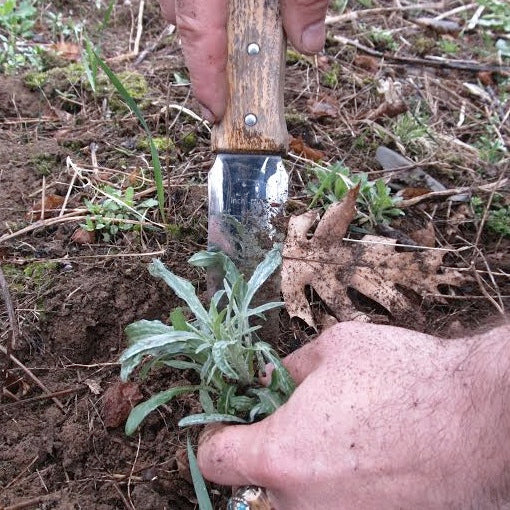
Garden Tool Maintenance
A gardener without reliable tools is a gardener with empty hands. And, with empty hands, tasks like prepping beds, planting, harvesting, weeding suddenly seem impossibly hard. Don't get stuck empty-handed! We learn this lesson every time we find ourselves in the farthest corner of the seed farm without the right instrument for the task at hand. Aside from the occasional help of a motorized tiller (BCS), everything we do on the farm happens with the aid of elbow grease. Needless to say, we’ve come to appreciate good tools almost as much as good soil and good seeds (well, not quite as much). Here's how to keep them in working order season after season:
CLEANING: Ideally, tools should be cleaned after each use (though as busy gardeners, we think it’s okay for this to be an aspiration).
- To clean hand-tools, rinse them with a hose or soak briefly in water. Wipe any remaining debris with a rag and, most importantly, wipe all metal parts completely dry, to avoid corrosion.
- If rust does occur, just scrub it away with steel wool or pumice.
- If you tool has been in contact with a diseased plant, wash it extra thoroughly and considering disinfecting with alcohol or hydrogen peroxide solution to avoid spreading disease.
- Once the tool is clean and dry, rub the metal parts with oil (try to avoid petroleum based products by opting for vegetable based oils instead).
SHARPENING: Most garden instruments have an edge or blade, and all are far more pleasant and efficient to use when that edge is sharpened. If you’ve never sharpened a shovel or a shear, the task can seem daunting, but it’s really no different than reviving a kitchen knife.
- The goal of sharpening is to return the cutting edge to its original angle. As tempting as it may be, don’t change the angle! (The only exception are tools manufactured with a stamping machine, which arrive with a dull edge. These can be sharpened to the typical 30 degree angle).
- A standard flat mill file will do the trick – just remember: it only cuts on the forward stroke, so don’t apply pressure when moving it backwards.
- If you have a vise available, it's helpful to secure the tool and get more control on the sharpening angle.
- This page from the University of Wisconsin Horticulture department provides great tips on maintaining specific garden tools
Blog post continues below!
FIXING: If a blade breaks, there’s little left to do unless you are friends with a metal-smith, but if well-cared for, the metal parts of garden tools can last for many years (at the Brooklyn Botanic Garden, some tools have been in continual use since 1908!). However, that’s not as true for wooden handles, which eventually give way under the stresses of garden work.
- Check all moving parts a few times per season and tighten and loose nuts and bolts
- Wooden handles should be inspected once a year. If they are loose or damaged, they should be replaced, to avoid the danger of having them break while in use.
- If they in good shape, scrub them with a rough brush, sand off any splinters, and rub with boiled linseed oil to preserve and waterproof.
- To replace, first remove all parts of the old handle. If it’s broken at the base or attached with worn out screws, this might take some effort. One trick is to put the tool into a campfire and let the wooden parts burn out (this tip came from a frustrated farmer who threw his axe into the fire when the broken handle wouldn’t budge, and woke up to a pleasant surprise in the ashes).
- Next, get a new handle and reattach with the necessary screws. Spare handles are often available at hardware stores and garden centers. An epoxy adhesive can be used where the handle meets the base if it’s not a snug fit.
STORAGE: Store your tools absolutely anywhere that's dry.







